Effective Strategies for Yard Ant Control
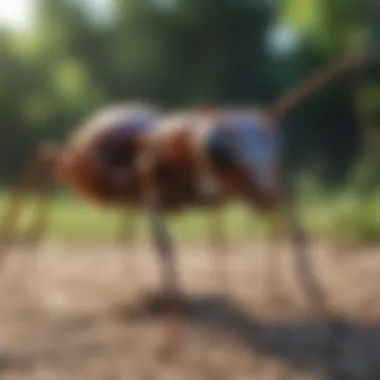
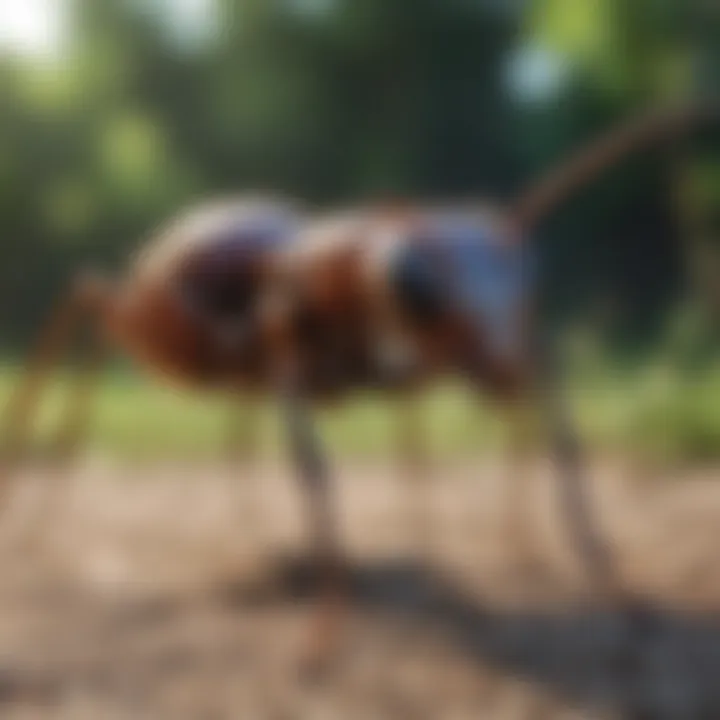
Intro
Dealing with yard ants can be a frustrating experience for homeowners and gardening enthusiasts. These small pests often invade outdoor spaces, disrupting tranquility and potentially damaging plants. Identifying the ants in your yard is the first important step. This knowledge enables you to choose appropriate control methods effectively. Different species require different approaches, and understanding their behavior is crucial for long-term solutions.
Several strategies exist for managing yard ants. Both natural and chemical methods can be employed effectively. However, it is essential to adopt an integrated pest management plan that considers environmental impact, safety, and results.
In this comprehensive guide, you will learn about effective ways to eliminate yard ants while keeping the ecosystem in mind. You'll find methods for species identification, prevention tips, and insights into the most effective control techniques. By following this guide, you will be better equipped to maintain a pest-free yard.
Understanding Yard Ants
Before implementing any strategies, it's important to understand the behavior and lifecycle of yard ants. Yard ants may include species like the Carpenter Ant or the Sugar Ant. Each has its own habits and vulnerabilities. For instance, Carpenter Ants are notorious for nesting in wood, whereas Sugar Ants are attracted to sweet substances.
Identifying the type of ant present in your yard is the first step in formulating an effective control plan.
Species Identification
Here are some common types of yard ants:
- Carpenter Ants: These ants nest in wood, often causing structural damage.
- Sugar Ants: Attracted to sugary foods, these ants can invade kitchens or outdoor eating areas.
- Fire Ants: Known for their aggressive behavior, fire ants can sting and cause allergic reactions.
By observing their unique characteristics and behaviors, homeowners can narrow down the species and tailor their control methods.
Effective Control Methods
Choosing a method to eliminate yard ants depends on the severity of infestation. Here are some control strategies:
Natural Methods
- Diatomaceous Earth: Sprinkle this powder near ant trails. It dehydrates the ants upon contact.
- Vinegar Solution: Mixing equal parts vinegar and water can disrupt ant pheromone trails. Spray along their pathways.
- Essential Oils: Peppermint and tea tree oil are known to repel ants. Mix with water and spray around entry points.
Chemical Methods
- Boric Acid: A mix of sugar, water, and boric acid can attract and kill ants. Place bait where ants are active.
- Insecticides: Commercial ant baits and sprays can be effective when used according to package instructions.
It's important to note that while chemical methods can yield quick results, they should be used sparingly and responsibly to minimize risks to humans and pets.
Prevention Tips
Preventing yard ant infestations involves regular maintenance of your outdoor area. Here are some practical steps:
- Maintain a clean yard. Remove food sources such as pet food or fallen fruits.
- Seal entry points around the home. Cracks and crevices can serve as entry for ants.
- Regulate moisture levels in the yard, as ants are drawn to damp environments.
By understanding ant behavior and adopting preventive measures, homeowners can minimize the chances of infestations.
Synthesizing Information
In summary, the battle against yard ants requires knowledge and strategic action. Understanding which species are present is crucial. Implementing a combination of natural and chemical methods may be necessary, depending on the situation. However, prevention through environment management remains key to long-term elimination.
By following the insights in this guide, homeowners can cultivate a peaceful, enjoyable outdoor space, free from the disruptions caused by yard ants.
Understanding Yard Ants
Understanding yard ants is essential for homeowners seeking to maintain a healthy outdoor environment. Yard ants can cause significant disturbance to gardens and lawns. Their presence may indicate underlying problems that deserve attention. Grasping the nature and habits of these ants will enable you to implement effective strategies for their elimination, thus protecting your investment in your home and landscape. This section will delve into the characteristics of yard ants, their common types, and their life cycle, providing a comprehensive background that will inform further discussion on control methods.
What Are Yard Ants?
Yard ants are small insects belonging to the family Formicidae. They play a crucial role in ecosystems by aerating the soil and controlling pest populations. However, when they invade residential areas, their behavior often leads to unwanted nuisance. Yard ants can consume seedlings, damage plant roots, and attract other pests like aphids due to their sugary secretions. Recognizing the invasive nature of these ants can prompt timely action before infestations become severe.
Common Types of Yard Ants
There are several ant species that can commonly invade yards. Among them are:
- Carpenter ants: Known for nesting in wood, they can cause structural damage to homes.
- Pavement ants: Often found in sidewalks and driveways, they create unsightly mounds in lawns.
- Odorous house ants: Notable for their distinctive smell, these ants can lead to indoor infestations as well.
Each type exhibits different behaviors and nesting preferences. Understanding which species inhabit your yard can aid in selecting targeted control measures.
The Life Cycle of Ants
The life cycle of ants is divided into four stages: egg, larva, pupa, and adult. Ant colonies start with a queen, who lays eggs after mating. The eggs hatch into larvae that require care from worker ants. As they mature, larvae enter the pupal stage before finally emerging as adults. A colony can grow rapidly, leading to more foraging workers and potential aggravation for homeowners. Knowing this cycle underscores the importance of early intervention when dealing with yard ants, as it takes only a short time for a few ants to become a substantial problem.
Identifying Ant Infestations
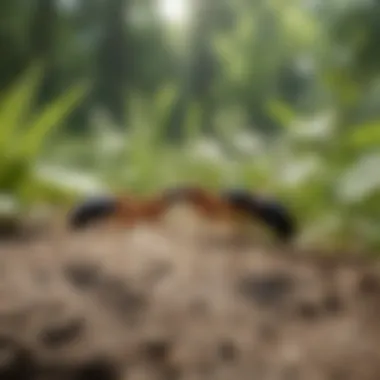

Understanding how to identify ant infestations is necessary for effective control. Recognizing the signs early can help homeowners take timely action, preventing bigger problems down the line. The presence of yard ants can disrupt outdoor enjoyment and negatively impact plants. Hence, knowing how to spot these pests is essential for maintaining a healthy yard environment.
Signs of an Ant Problem
There are various indications that might suggest an ant infestation in your yard. Some of the most notable signs include:
- Visible Ant Trails: Ants often follow the same pathways. If you spot a trail, it's a sign that you might have a nest nearby.
- Nesting Sites: Look for ant nests, which could be in the soil, under rocks, or within decayed wood. These sites might appear as small mounds or openings.
- Increased Activity Near Food Sources: If ants are seen scurrying around food scraps or sweet substances, they are likely searching for resources. This behavior often increases in warmer months.
Each sign offers clues on the severity of the problem. Homeowners can act quickly, preventing ants from further invading their space.
Assessing the Extent of Damage
Once signs of ants are confirmed, assessing the extent of damage is vital. This evaluation helps understand whether the infestation is localized or widespread. Look for:
- Damage to Plants: Wilting leaves or chewed stems can indicate that ants are consuming or farming aphids on those plants.
- Soil Displacement: Ants can create tunnels that may lead to uneven soil surfaces or even plant roots being exposed.
- Pavement Cracks: In worst cases, large colonies can disrupt pavements or walkways, creating cracks or shifting structures
By understanding damage effects, strategies can be tailored to manage the situation more effectively. Identifying the specific problem leads to more efficient solutions, helping restore yard health.
Mapping Ant Trails
Mapping out ant trails provides critical insights for effective treatment. Observing where the ants move can lead you to their nest location. Steps to do this:
- Track Their Movement: Spend some time watching the ants. Take note of their direction and frequency, as this can reveal well-established trails.
- Identify Food Sources: Ants usually follow paths to food. Finding where they gather nourishment can help you understand why they are present.
- Document Their Paths: Drawing a simple diagram of their path can reveal patterns. This is beneficial for targeting treatment.
Mapping trails not only aids in finding nests but also helps homeowners apply treatments precisely where they will be most effective.
By taking these steps, homeowners gain a clearer view of the ant problem, allowing for better planning in their eradication efforts.
Preventive Measures
Preventive measures play a crucial role in the control of yard ants. By taking proactive steps, homeowners can significantly reduce the likelihood of an infestation before it even starts. Understanding the specific elements of preventive measures can guide effective strategies that limit ant attraction and entry into your living space.
The benefits of a strong preventive approach are numerous. First and foremost, it reduces not only the ant population but also minimizes property damage. Ants can disrupt soil, destroy plants, and compromise structures. Additionally, preventive measures save both time and resources. Addressing an infestation after it occurs is often more costly, requiring urgent treatments and possibly professional pest control services. Taking time to implement these measures now can pay off in dividends later.
Considerations for preventive measures should include daily yard maintenance and careful landscaping choices. A clean yard free of food debris and standing water is less enticing to ants. Homeowners need to stay vigilant and conduct regular checks of the property.
"An ounce of prevention is worth a pound of cure; knowing this truth is essential in pest management."
Maintaining Yard Hygiene
Keeping a clean yard is among the simplest yet most effective methods to prevent ant infestations. Ants are notorious for being drawn to food sources and shelter. Regularly cleaning your yard ensures there is minimal attraction for these pests.
Start by picking up any leftover food or spills that may have occurred during outdoor events. Fallen fruits, vegetable scraps, or pet food can act as beacons for ants. Raking leaves and removing organic debris can also reduce hiding places for them.
Ensure that trash bins are sealed tightly and away from areas where ants can easily access them. If there’s a barbecue area, cleaning the grill and surrounding space promptly after use is essential.
Sealing Entry Points
Another critical preventive measure is sealing entry points. Ants often enter homes through small cracks and crevices, making it vital to inspect the exterior for such vulnerabilities.
Begin by checking windows and doors. Look for gaps around frames and use weather stripping or caulking to close any openings. Be careful around utility lines, where ants can find pathways into your home, and seal those as needed.
Regular inspection of your foundation is necessary. Even the tiniest crack can serve as an invitation for ants. If you have areas where soil is in contact with wood or siding, consider using barriers that inhibit ant movement.
Creating Barriers
Creating physical barriers can also deter ants from entering your yard and home. This can involve strategies like installing ant baits or applying diatomaceous earth along trails and potential entryway areas.
Diatomaceous earth is a natural, non-toxic powder that, when applied, can disrupt the exoskeletons of ants and deter them from nesting. Place it around the perimeter of your home and in likely entry points.
Additionally, landscaping choices can help include barriers. Consider using gravel or rocks around flower beds or patios to make it less appealing for ants to burrow.
In summary, preventive measures form the first line of defense against yard ants. Regular yard hygiene, sealing entry points, and creating barriers each contribute to creating an environment where yard ants struggle to thrive. These strategies should not only be implemented for immediate effect but also thought of as long-term practices.
Natural Control Methods
Natural control methods provide environmentally friendly and sustainable options for eliminating yard ants. Homeowners increasingly seek alternatives to chemicals, considering both the effectiveness and safety of their outdoor spaces. Natural solutions often have fewer negative impacts on the ecosystem, contribute to overall garden health, and can be more cost-effective.
Using Essential Oils
Essential oils are concentrated plant extracts that can deter ants effectively. Oils like peppermint, tea tree, and citrus have strong scents that ants find unappealing. To use essential oils, combine a few drops of your chosen oil with water in a spray bottle. Spray the mixture directly on ant trails and entry points. This not only disrupts their pheromone trails but also creates an unpleasant environment for the ants.
Benefits of essential oils include:
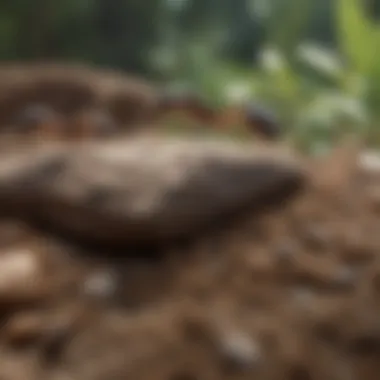
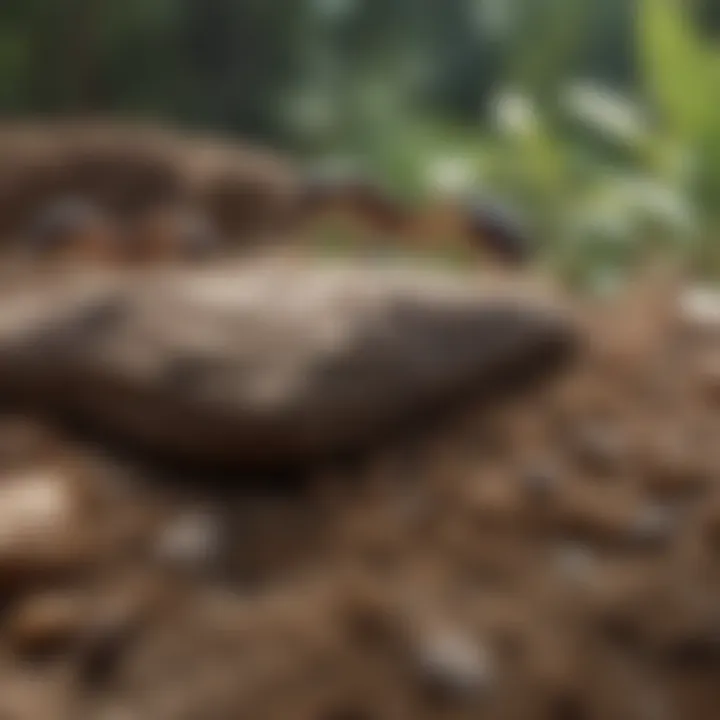
- Safety for pets and children: Unlike many chemicals, essential oils are generally safe when used correctly around humans and animals.
- Natural aroma: They can leave your yard smelling pleasant, unlike synthetic pesticides.
Considerations include dilution and choice of oil, as some oils can be more effective than others.
Homemade Ant Baits
Creating homemade ant baits is a practical way to control ants using common household ingredients. Combine sugar, which attracts ants, with a poison like borax. The ants carry the bait back to their colony, effectively eliminating many ants at once. A simple ratio might be one part borax to three parts sugar mixed with water to form a paste.
Key Steps:
- Mix sugar and borax in equal parts.
- Add water to create a paste.
- Place small amounts on pieces of cardboard and position them near ant trails.
This method focuses on the colony's destruction rather than just removing visible ants.
Utilizing Beneficial Insects
Introducing beneficial insects is another natural control method. Certain insects prey on ants, naturally reducing their population. For instance, ladybugs and lacewings consume aphids, which attract ants. By promoting a healthy ecosystem with these helpful insects, the balance in your garden supports fewer pest problems.
Strategies for encouraging beneficial insects:
- Plant diversity: Grow a variety of plants, which attract different beneficial insects.
- Avoid pesticides: Chemicals can harm beneficial insects. Focus on natural alternatives.
By adopting these strategies, homeowners can cultivate a pest-resistant yard while fostering a balanced ecosystem.
"Natural control methods are a crucial element in the management of yard ants, contributing to healthier gardens and safer environments."
Considering these natural control methods is important for long-term pest management. Each approach provides unique benefits, and often, a combination may yield the best results. This encourages a thoughtful, sustainable approach to garden care.
Chemical Control Methods
Chemical control methods serve a crucial role in combating yard ant infestations. While natural alternatives often prove effective, there are instances where chemical solutions are necessary. Understanding the types of pesticides available and how to implement them correctly is essential for effective ant removal.
Identifying Effective Pesticides
Selecting the right pesticide is critical. Not all products are created equal, and effectiveness varies by the ant species present. Common options include:
- Boric acid: Effective for many ant species, it disrupts their digestive systems.
- Fipronil: A slow-acting insecticide, it allows ants to carry it back to their colony.
- Pyrethroids: Synthetic chemicals that target the nervous system of ants, causing paralysis and death.
Research the specific pest problem you are dealing with to choose the best solution. Always read the label for directions and safety information.
Application Techniques
Correct application of pesticides ensures maximum effectiveness while minimizing risks. Some useful techniques include:
- Spot treatment: Apply directly to areas with high ant activity.
- Granular application: Spread granules in strategic places; moisture will activate them.
- Barrier treatment: Create a perimeter around your yard using a liquid spray to prevent establishment.
Timing is important—apply during active hours for the ants, usually early morning or late afternoon.
Safety Precautions
When using chemical methods for ant control, safety should be a priority. Consider the following precautions:
- Read labels: Understand the product’s safety instructions.
- Protective gear: Use gloves and masks if advised on the label.
- Keep pets and children away: Ensure the treated area is off-limits until chemicals dry.
- Avoid over-application: More is not necessarily better; follow the recommended dosage to prevent harm to non-target species.
Important: Always dispose of leftover pesticides according to your local regulations to protect the environment.
Integrated Pest Management
Integrated Pest Management (IPM) plays a crucial role in effectively eliminating yard ants. It is not just about applying pesticides indiscriminately; instead, it involves a comprehensive strategy that incorporates various control methods and focuses on understanding ant behavior. IPM emphasizes a sustainable approach to pest control, minimizing risks to humans, pets, and the environment while maintaining the health of your yard.
Principles of IPM
The core principles of IPM are built around a proactive and informed approach to pest management.
- Prevention: This is the first line of defense. Keeping your yard clean and free of food sources significantly reduces the likelihood of an ant infestation. Simple actions, such as securing food items and regularly maintaining the lawn, are vital.
- Identification: Correctly identifying the species of ants present is essential for effective management. Different species may require different control strategies.
- Monitoring: Regular inspections of your yard help track any changes or signs of ant activity. This includes observing trails, nests, and other indicators of an infestation.
- Control: Utilizing a combination of natural and chemical methods tailored to the specific ant species observed ensures a more targeted and effective approach.
- Evaluation: Assessing the effectiveness of the implemented strategies allows for adjustments in your pest management plan.
Monitoring and Evaluation
Monitoring and evaluation are integral components of IPM. Understanding how and when to monitor helps identify potential infestations before they become overwhelming.
- Regular Inspections: Check for signs of ants, such as small dirt mounds or visible trails. Look under rocks and near plants.
- Evaluation of Control Methods: After applying treatments, evaluate their impacts. If the number of ants remains high or increases, you may need to reassess your methods.
- Documentation: Keep a record of pest sightings, control methods used, and their effectiveness. This assists in identifying patterns and refining your strategy.
Long-term Strategies
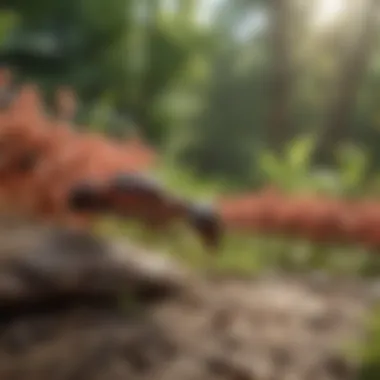
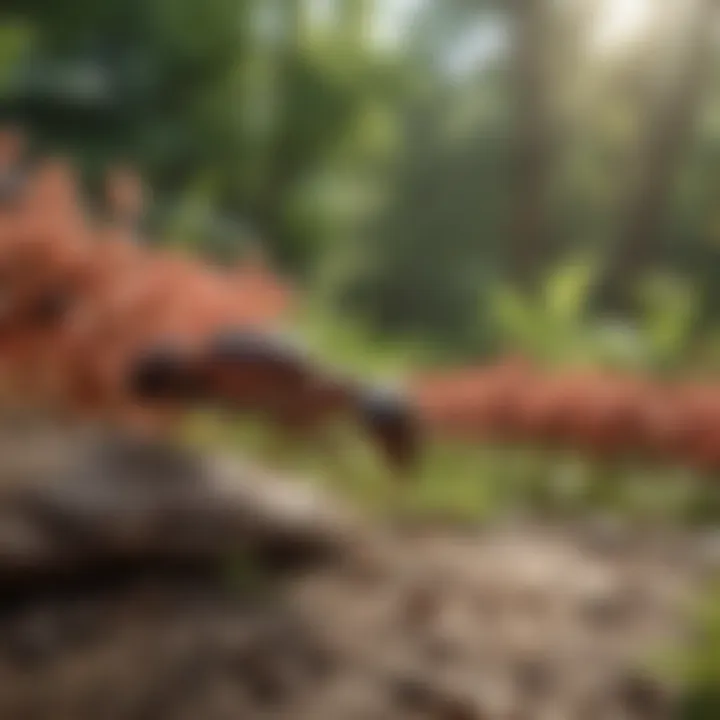
Implementing long-term strategies within the framework of IPM ensures that your yard remains ant-free.
- Sustainable Practices: Focus on sustainable gardening practices. This includes using organic fertilizers and creating habitats for beneficial insects that prey on harmful pests.
- Regular Maintenance: Establish a routine that incorporates yard hygiene, proper planting, and ongoing monitoring. Keeping your environment non-conducive to pests is key.
- Education: Stay informed about ant behavior and new pest management techniques. Knowledge empowers you to make better decisions and adapt to changes.
"The best way to manage pests is to understand them; knowledge is your greatest ally in IPM."
An integrated approach to pest management fosters an understanding of ecology while providing homeowners with effective and sustainable pest control solutions. This balance is vital for maintaining healthy outdoor spaces.
Yard Maintenance Tips
Maintaining a yard is crucial to preventing infestations of yard ants. Yard maintenance not only improves the aesthetic appeal of your outdoor space, but also minimizes the factors that attract ants and other pests. Regular yard care practices help in identifying problems early on and taking appropriate measures before the situation escalates. A well-maintained yard can make it less inviting for ants to establish colonies, thus protecting your home from infestations.
Regular Lawn Care
Regular lawn care involves frequent mowing and trimming of grass and plants. Keeping grass at a suitable height prevents overgrowth that can provide shelter for ants. It is advisable to mow the lawn at least once a week during the growing season. Additionally, remove any weeds that might attract ants. Weeds often harbor a variety of pests and can accumulate moisture, making them a suitable breeding ground.
Maintaining edges and borders is also important. This can be achieved by trimming hedges and bushes that potentially touch the ground. Ensuring that there are no overhanging branches that touch the lawn can limit the pathways that ants use to access your yard.
Proper Watering Techniques
Watering your lawn effectively is vital. Proper watering techniques lead to a healthier lawn. Over-watering can create an environment conducive to ant infestations, as puddles and standing water attract ants.
Adopt a watering schedule that allows the soil to dry out between sessions. Watering in the early morning or late evening is often most effective. This reduces evaporation and allows water to permeate the soil, discouraging ant activity. If possible, use soaker hoses or drip irrigation to ensure water penetrates deeply into the soil, promoting strong root growth while minimizing surface moisture.
Seasonal Maintenance Practices
Seasonal maintenance is an essential part of any successful yard management plan. Apply mulch around flowerbeds and trees in the spring. Mulch can help retain soil moisture and prevent weed growth, but it should not be too thick, as this can create a conducive environment for ants.
In the fall, remove fallen leaves and debris. Yard waste left unattended can be a nesting area for ants. Take time to assess your yard in each season, identifying conditions that may encourage ant activity. Completing these maintenance activities optimally enhances the condition of your yard and keeps ant populations in check.
"Regular upkeep can significantly reduce the likelihood of yard ants finding a suitable habitat in your outdoor space."
When to Seek Professional Help
Identifying the right moment to call in experts can make a significant difference in the management of yard ant infestations. It is essential to assess the situation carefully. Homeowners often underestimate the severity of an ant problem until it becomes overwhelming. Understanding when to seek assistance not only saves time but also often leads to more effective solutions.
Recognizing Severe Infestations
Severe infestations are characterized by visible ant trails and nests. When you consistently see large numbers of ants in your yard or around your home, this signals a problem that could be escalating. Other indicators include ants invading your home, especially areas where food is stored or consumed. If you notice signs of damage to plants, that can also point to a significant ant presence.
A critical factor is the rapidity of their population growth. In cases where they reproduce quickly, DIY methods may not suffice, leading to prolonged issues.
It's crucial to remember that delaying intervention can result in larger problems down the line.
Choosing a Pest Control Service
Selecting the right pest control service is crucial when facing a yard ant infestation. Look for companies with solid reputations and experience in dealing specifically with ant control. Checking online reviews can provide valuable insights into their effectiveness.
When you consult with potential service providers, ensure they offer integrated pest management strategies. This approach combines a variety of techniques to address the problems based on the specific characteristics of your yard. Make sure to ask about their treatment plans and whether they use environmentally friendly methods, as this can also impact your overall yard health.
Consider inquiring if they provide follow-up services. Comprehensive pest control often requires ongoing treatment and monitoring to prevent re-infestation.
Cost Considerations
The cost of pest control services for eliminating yard ants can vary. Factors affecting the price include the severity of the infestation and the type of treatments used. On average, homeowners might expect to pay a few hundred dollars for initial treatments, with additional costs for follow-ups.
When budgeting, it is wise to gather quotes from multiple services. This not only allows you to compare costs but also gives you a sense of what services are standard for this type of work. Don't forget to consider the long-term benefits of investing in professional help. While the initial outlay might seem considerable, effective treatment can save money in the long run by preventing further damage and control costs.
In summary, understanding the signs of a severe infestation, carefully choosing a pest control service, and considering potential costs are essential to effectively addressing yard ant problems. It is often best to act decisively to ensure your yard remains an enjoyable space.
Concluding Thoughts
Eliminating yard ants requires a comprehensive approach. This guide illuminated several strategies to effectively manage ant populations in outdoor spaces. The primary takeaway is the necessity of integrating various methods tailored to specific needs. Homeowners must understand the significance of both preventative and reactive strategies to maintain a pest-free environment.
Recap of Effective Strategies
To summarize the strategies discussed earlier:
- Understanding the Species: Identifying yard ants helps in choosing the correct control method.
- Preventive Measures: Maintaining cleanliness and sealing potential entry points minimizes chances of infestation.
- Natural Controls: Employing non-toxic methods like essential oils and beneficial insects supports a sustainable approach.
- Chemical Options: Utilizing pesticides effectively, while adhering to safety protocols, offers a quick remedy.
- Integrated Pest Management (IPM): This holistic approach combines various strategies for long-term control and reduces the reliance on any single method.
The importance of these aspects lies in their synergy. When combined, they create a robust defense against yard ants.
Moving Forward with a Pest-Free Yard
Continuing with a pest-free yard involves persistent attention to practices that prevent future infestations. Here are steps to consider:
- Regular Inspections: Regularly checking for signs of ant activity will facilitate early intervention.
- Continuous Education: Staying informed about ant behavior and the latest control methods will enhance your ability to manage infestations effectively.
- Community Collaboration: Sharing strategies with neighbors can amplify the overall effectiveness, as collective efforts have a larger impact on pest control.
- Adaptation and Flexibility: Be ready to adapt your methods based on seasons, changing conditions, and the nature of the infestation.
By implementing these practices, homeowners can cultivate a resilient outdoor space, ensuring that yard ants remain a distant concern rather than a recurring problem. This proactive mindset is crucial in achieving and sustaining a peaceful, pest-free environment.







